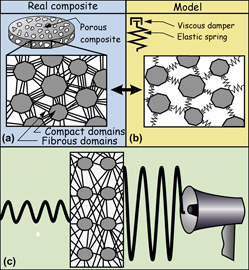Crossref Citations
This article has been cited by the following publications. This list is generated based on data provided by
Crossref.
Rutkevičius, Marius
Austin, Zak
Chalk, Benjamin
Mehl, Georg H.
Qin, Qin
Rubini, Philip A.
Stoyanov, Simeon D.
and
Paunov, Vesselin N.
2015.
Sound absorption of porous cement composites: effects of the porosity and the pore size.
Journal of Materials Science,
Vol. 50,
Issue. 9,
p.
3495.
Kumar, Anil
Mollah, Asfak Ali
Keshri, Anup Kumar
Kumar, Manoj
Singh, Kulvir
Rallabhandi, Krishna Dutt Venkata Shiva
and
Seelaboyina, Raghunandan
2016.
Development of Macroporous Silicone Rubber for Acoustic Applications.
Industrial & Engineering Chemistry Research,
Vol. 55,
Issue. 32,
p.
8751.
Yang, Xiaoli
Zhou, Lihua
Lv, Le
Zhao, Xin
and
Hao, Lingyun
2016.
Multi-stimuli-responsive poly(NIPA-co-HEMA-co-NVP) with spironaphthoxazine hydrogel for optical data storage application.
Colloid and Polymer Science,
Vol. 294,
Issue. 10,
p.
1623.
Chen, Po-Hsiu
Xu, Chi
and
Chung, D.D.L.
2016.
Sound absorption enhancement using solid–solid interfaces in a non-porous cement-based structural material.
Composites Part B: Engineering,
Vol. 95,
Issue. ,
p.
453.
Thompson, Benjamin R.
Taylor, Brogan L.
Qin, Qin
Stoyanov, Simeon D.
Horozov, Tommy S.
and
Paunov, Vesselin N.
2017.
Sound transmission loss of hierarchically porous composites produced by hydrogel templating and viscous trapping techniques.
Materials Chemistry Frontiers,
Vol. 1,
Issue. 12,
p.
2627.
Thompson, Benjamin R.
Horozov, Tommy S.
Stoyanov, Simeon. D.
and
Paunov, Vesselin N.
2019.
Hierarchically structured composites and porous materials from soft templates: fabrication and applications.
Journal of Materials Chemistry A,
Vol. 7,
Issue. 14,
p.
8030.
Sun, Yi
Chen, Le-Gao
Fan, Xiao-Ming
and
Pang, Jian-Liang
2022.
Ultrasound Responsive Smart Implantable Hydrogels for Targeted Delivery of Drugs: Reviewing Current Practices.
International Journal of Nanomedicine,
Vol. Volume 17,
Issue. ,
p.
5001.
Roh, Sojeong
Phan, Thi Thu Trinh
and
Lee, Jun Seop
2023.
PEDOT:PSS-based three-dimensional lamella network for high-performance sound absorption and heat transfer.
Journal of Materials Science,
Vol. 58,
Issue. 16,
p.
6972.
Phan, Thi Thu Trinh
Roh, Sojeong
and
Lee, Jun Seop
2023.
Conductive Three-Dimensional Lamella Network for Improved Sound Absorption and Heat Transfer.
ACS Applied Polymer Materials,
Vol. 5,
Issue. 4,
p.
2852.
Wijekoon, Nelum K.
Appuhamillage, Gayan A.
Dassanayake, Rohan S.
Liyanage, Renuka N.
Mapage, Dulanjaya
Wijenayake, Achintha
Lokuge, Eshani L.
Rajapaksha, Suranga M.
Abeygunawardane, Gayan A.
and
Senarath, N.D.D. Danuka
2024.
Facile fabrication of 3D-printed cellulosic fiber/polylactic acid composites as low-cost and sustainable acoustic panels.
Sustainable Chemistry for the Environment,
Vol. 8,
Issue. ,
p.
100168.
He, Jiawen
Yu, Haojie
Wang, Li
Yang, Jian
Zhang, Yanhui
Huang, Wenbing
and
Ouyang, Chenguang
2024.
Hygroscopic photothermal sorbents for atmospheric water harvesting: From preparation to applications.
European Polymer Journal,
Vol. 202,
Issue. ,
p.
112582.
